
The Uffizi Gallery is a prominent art museum located adjacent to the Piazza della Signoria in the Historic Centre of Florence in the region of Tuscany, Italy. One of the most important Italian museums and the most visited, it is also one of the largest and best known in the world and holds a collection of priceless works, particularly from the period of the Italian Renaissance.

Filippino Lippi was an Italian painter working in Florence, Italy during the later years of the Early Renaissance and first few years of the High Renaissance.
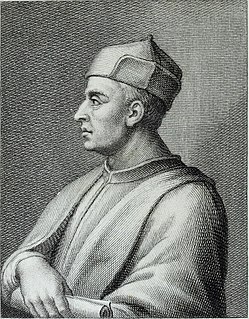
Luca Signorelli was an Italian Renaissance painter who was noted in particular for his ability as a draftsman and his use of foreshortening. His massive frescoes of the Last Judgment (1499–1503) in Orvieto Cathedral are considered his masterpiece.
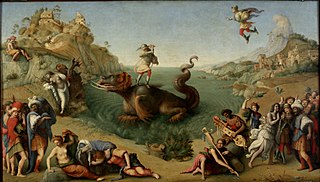
Piero di Cosimo, also known as Piero di Lorenzo, was an Italian painter of the Renaissance.
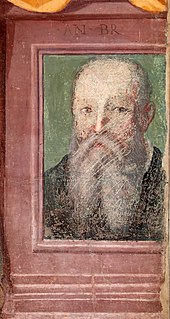
Agnolo di Cosimo, usually known as Bronzino or Agnolo Bronzino, was an Italian Mannerist painter from Florence. His sobriquet, Bronzino, may refer to his relatively dark skin or reddish hair.

The Holy Family consists of the Child Jesus, the Virgin Mary, and Saint Joseph. The subject became popular in art from the 1490s on, but veneration of the Holy Family was formally begun in the 17th century by Saint François de Laval, the first bishop of New France, who founded a confraternity.

The Savelli were a rich and influential Roman aristocratic family who rose to prominence in the 13th century and became extinct in the main line with Giulio Savelli (1626–1712).

Orvieto Cathedral is a large 14th-century Roman Catholic cathedral dedicated to the Assumption of the Virgin Mary and situated in the town of Orvieto in Umbria, central Italy. Since 1986, the cathedral in Orvieto has been the episcopal seat of the former Diocese of Todi as well.
The decade of the 1490s in art involved some significant events.

Andrea del Sarto was an Italian painter from Florence, whose career flourished during the High Renaissance and early Mannerism. He was known as an outstanding fresco decorator, painter of altar-pieces, portraitist, draughtsman and colorist. Though highly regarded during his lifetime as an artist senza errori, his renown was eclipsed after his death by that of his contemporaries, Leonardo da Vinci, Michelangelo and Raphael.

The Portrait of a Man is a painting by the Italian Renaissance artist Luca Signorelli, dated to c. 1492 and housed in the Gemäldegalerie, Berlin.

Pietà is a painting by the Italian Renaissance artist Pietro Perugino, executed around 1483-1493, and housed in the Uffizi Gallery, Florence.

The Madonna with Child and Saints is a painting by the Italian late Renaissance painter Luca Signorelli, executed around 1519-1523. It is housed in the Museo Nazionale di Castel Sant Angelo, Rome, Italy. The picture is a traditional Holy Conversation composition.
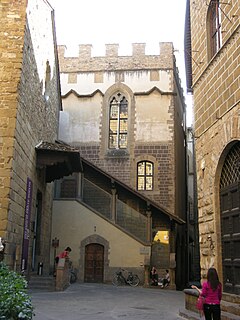
The Palazzo di Parte Guelfa is a historical building in Florence, central Italy. During the Middle Ages, it was the headquarters of the Guelph party in the city.

Crucifixion is a painting of the Crucifixion of Christ, usually attributed to Perugino, with or without assistance from Luca Signorelli. The work's dating and attribution are both uncertain - Venturi and Schmarsow attribute it to a pupil of Perugino, whilst other art historians attribute it to Perugino alone or with assistance from Signorelli. The deep chiaroscuro is comparable to Signorelli's style elsewhere or to the early style of Perugino whilst he was still heavily influenced by Verrochio. The landscape background is typical of Perugino, with mountains and hills in deep perspective.
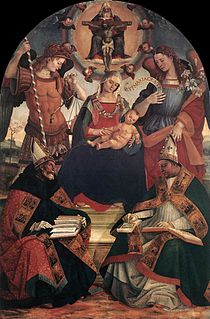
Madonna and Child with the Holy Trinity and Two Saints is a painting by Luca Signorelli, from 1510, now in the Uffizi in Florence. It is a sacra conversazione, with the Madonna enthroned between Michael and Gabriel, with Augustine (left) and Athanasius (right) below and the Holy Trinity above.

Allegory of Fertility and Abundance is a allegorical tempera on panel painting by Luca Signorelli, created c. 1500, now in the Uffizi in Florence. Produced around the same time as the artist's frescoes in the San Brizio Chapel in Orvieto, the work is a monochrome allegory inspired by classical bas-reliefs and intended for a humanist scholar's studiolo. Its figures refer to the artist's nudes in his frescoes at Orvieto and Madonna and Child with Ignudi.

Madonna and Child with Ignudi is a tempera on panel painting by Luca Signorelli, created c. 1490, produced for the Medici Villa di Castello, where it was seen by Giorgio Vasari. It was probably a commission from Lorenzo di Pierfrancesco de' Medici, who also commissioned Primavera and Birth of Venus from Botticelli. It is now in the Uffizi in Florence. Its title refers to the ignudi in the background.

Madonna and Child is a tempera on panel tondo painting by Luca Signorelli, created c. 1492-1493, now in the Alte Pinakothek in Munich. The rocky landscape in the background shows the influence of Leonardo da Vinci, whilst to the right is a nude seated on a rock, referencing the marble Spinario, which at that date was already in the Uffizi in Florence.

Holy Family or Holy Family with a Female Saint is a tempera on panel painting by Luca Signorelli, created c. 1490-1495, now in the Galleria Palatina in Florence.



















